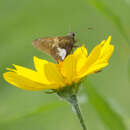Conservation Status
provided by University of Alberta Museums
May be sensitive to valley flooding, but currently secure.
- license
- cc-by-nc
- copyright
- University of Alberta Museums
Cyclicity
provided by University of Alberta Museums
Adults are most often encountered between late June and early July.
- license
- cc-by-nc
- copyright
- University of Alberta Museums
Distribution
provided by University of Alberta Museums
Found throughout most of the continental United States, and in southern Canada west to southern BC (Opler 1999). The northernmost population in North America is associated with patches of the larval hostplant in the North Saskatchewan river valley in Edmonton.
- license
- cc-by-nc
- copyright
- University of Alberta Museums
General Description
provided by University of Alberta Museums
This is Alberta's largest skipper; its 44 to 60 mm wingspan, and the large, silver hindwing patch make it very distinctive. The nominate subspecies occurs in Alberta (Bird et al. 1995).
- license
- cc-by-nc
- copyright
- University of Alberta Museums
Habitat
provided by University of Alberta Museums
River valleys and badlands in the prairie and parkland region.
- license
- cc-by-nc
- copyright
- University of Alberta Museums
Life Cycle
provided by University of Alberta Museums
There is one yearly brood, and mature larvae are green with black bands and a dark brown head. Larvae construct shelters out of the host plant leaves, at first cutting and folding part of the leaf over them, but tying several leaves together as larvae grow larger (McCabe & Post 1977). Pupae hibernate in leaf nests near the ground, often on the foodplant itself (Layberry et al. 1998). The egg is greenish and round. Males are aggressive fliers, and often chase one another (Bird et al. 1995). The Silver-spotted skipper is uncommon in Alberta, and occurs in local colonies.
- license
- cc-by-nc
- copyright
- University of Alberta Museums
Trophic Strategy
provided by University of Alberta Museums
The larvae feed on wild licorice (Glycyrrhiza lepidota) in Alberta (Bird et al. 1995). Other legume species have also been reported from the eastern parts of this skipper's range (McCabe & Post 1977, Layberry et al. 1998).
- license
- cc-by-nc
- copyright
- University of Alberta Museums

